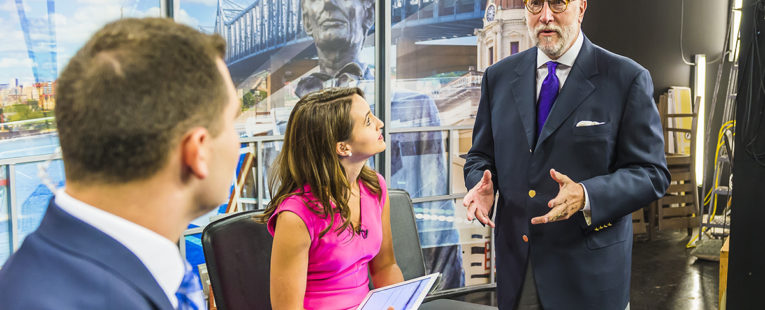Kevin Harlan always thought he was relatively healthy. He never smoked, he didn’t have a family history of cardiovascular disease or stroke, he ate a fairly healthy diet and wasn’t reliant on any regular medication.
At age 63, Kevin didn’t regularly see a primary care provider. Instead, every five years or so, Kevin would undergo screenings that detect early risks for cardiovascular disease and certain types of cancer.
Screening
He had one of those screenings earlier this year, “and the results suggested I might have a problem with my carotid artery, and that I should follow-up with someone,” said Kevin, who is active on numerous civic boards in Peoria, including OSF HealthCare Children’s Hospital of Illinois. He is also the vice president and general manager of WMBD/WYZZ in Peoria.
Kevin arranged for an appointment with OSF HealthCare Cardiovascular Institute, where he underwent a sonogram on his left and right carotid arteries.
“The technician studied the right side and said, ‘Oh, that looks great.’ Then the technician looked at the left side and said, ‘I’ll be right back.’ … Three people came back into the room,” he said.
Kevin, who was just beginning to grasp the severity of his situation, was told to go to the emergency room immediately, and not to drive himself.
“My wife, Mary Kaye, picked me up and we went to the emergency room” at OSF HealthCare Saint Francis Medical Center.
That was February 3, 2017.
Emergency surgery
The following day, James Munns, MD, with OSF HealthCare Cardiovascular Institute told Kevin he had 95 percent blockage in his left carotid artery. He explained that his risk for stroke was high as the carotid arteries are the main blood vessels that carry oxygen to the brain. When these arteries become narrowed due to a buildup of plaque – also called hardening of the arteries – it reduces blood flow to the brain and increases the risk of a stroke.
“Dr. Munns said they’d make an incision and clean it out,” Kevin said.
The next day, Dr. Munns performed a carotid endarterectomy, where he made an incision on the side of Kevin’s neck and surgically removed the plaque that had built up inside the artery.
“It’s about opening up the artery, shelling out the obstructing plaque and sewing a patch on so the artery stays open,” Dr. Munns said.
The recovery time in the hospital is about 24 hours.
“And then you go home and pretty much go back to your routine activities,” Dr. Munns said.
Kevin went home the next day.
As for the prognosis, Dr. Munns said there needs to be follow-ups to monitor for any redevelopment.
“As for prevention, it’s the usual things — have control of your blood pressure, don’t smoke and exercise regularly,” he said.
Lifestyle changes
Kevin and his wife now eat predominantly salads with some fish and chicken, except for an occasional hamburger on Saturday date nights. He’s lost weight and is on medicine to keep his blood pressure down.
“It only takes one life-threatening event to get my attention,” he said.
Pleased with his care and his outcome, Kevin advises others to not put off preventive check-ups “so you’re not rushed to the hospital like I was.”
Today he’s back to his regular, active life – working about 65 hours a week operating the two television stations, in addition to his side job – designing and creating percussion instruments for use by symphonies around the world.
His tambourine, the Harlan Tambourine, is made with a strong, yet light hardwood frame, goat skin head and generously sized brass, bronze or German Silver jingles for greater control of tone and volume. It is used by groups such as the New York Philharmonic, the London Symphony, The Joffrey Ballet and the Singapore Symphony to name a few.
The tambourines occupy Kevin in his workshop on Saturday mornings and those times when he doesn’t have to think about television.
“It’s my golf,” he said.
Last Updated: April 26, 2018
